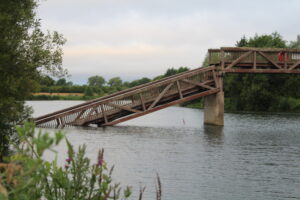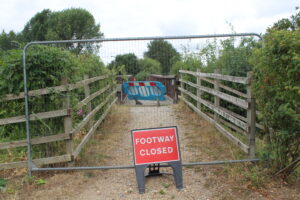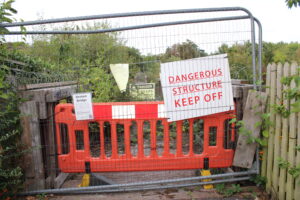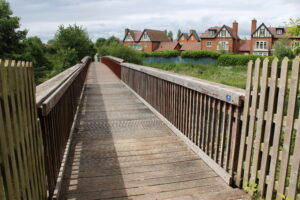
Ashford Lane footbridge collapsed – June 2025.


Berry Hill footbridge closed – October 2023

Berry Hill footbridge partially replaced June 2024
This is my (assisted by AI) hypothesis – on the primary causes of short life and premature failure of timber footbridges over the Jubilee River and thereabouts in the Thames Catchment area. Sadly, the potential collapse of these timber footbridges is inevitable and a direct consequence of multiple shortcomings. My point is that – today – those who should be accountable (the EA) fail to learn – and are not required to pay.
CONCLUSION
It is my view that a comprehensive review of current practices and implementation of improved standards across all phases of timber footbridge delivery from concept onwards IS ESSENTIAL in order to break this cycle of premature failure. Passing the problem around is not a solution. Somebody somewhere needs to be accountable – and to pay.
INTRODUCTION
The Thames catchment area, particularly around the Jubilee River, has witnessed a concerning pattern of premature failure among timber footbridges. Notable examples include the Temple, Berry Hill, Ashford Lane, The Myrke, and Black Potts footbridges. There are others. These structures, designed to provide essential pedestrian access across waterways, have consistently failed to achieve their intended design life, resulting in safety concerns, recurring replacement costs, and disruption to public access and the flood defence function of land drainage infrastructure. In my opinion even the replacement of the centre section of the Berry Hill footbridge needs to be re-examined.
This article presents my hypothesis that the shortened lifespan of these timber footbridges results from a combination of interconnected factors that compound to accelerate structural deterioration and compromise safety.
Rather than single-point failures, these timber footbridges suffer from systemic issues that begin at the design stage and persist throughout their operational life until they fail.
THE PRIMARY CAUSES OF FAILURE
1. POOR DESIGN
The foundation of any successful bridge lies in its design, yet many of these timber footbridges exhibit fundamental design flaws. Common issues include inadequate consideration of local environmental conditions, insufficient allowance for thermal expansion and contraction, water ingress and poor drainage integration. The design phase often fails to account for the specific challenges posed by the Thames catchment environment, including seasonal extremes, high humidity, and variable orientation and ground conditions.
Furthermore, structural designs can underestimate loading requirements, particularly dynamic loads from pedestrian traffic and loading during storms. The interconnection details between timber members often lack proper consideration for differential movement, leading to stress concentrations and premature joint failure.
2. INCORRECT MATERIAL SELECTION
Material selection represents a critical decision point where many projects falter. The choice of timber species, treatment methods, and hardware specifications directly impacts longevity. Many installations utilize softwood species that, while economical, lack the durability required for exposed external conditions in a high-moisture environment.
The selection of inappropriate fasteners, brackets, and connection hardware compounds the problem. Steel components without adequate corrosion protection accelerate deterioration through galvanic action and rust staining. Additionally, the use of timber grades unsuitable for structural applications or external exposure conditions significantly reduces service life.
3. SUB-STANDARD MATERIALS
Even when appropriate materials are specified, the actual materials delivered and installed often fall short of requirements. The longitudinal grain structure of beams and girders is particularly important. Timber may be inadequately seasoned, leading to excessive movement and splitting. Preservative treatments may be incomplete or applied to timber with excessive moisture content, reducing penetration and effectiveness. Quality control during material procurement appears insufficient, with inadequate verification of treatment levels, grading stamps, and moisture content. This results in the installation of materials that are fundamentally compromised from the outset, regardless of design adequacy or construction quality.
4. SUB-STANDARD MANUFACTURING
The manufacturing and fabrication phase represents a critical stage where design intent must be translated into physical reality. However, many timber footbridge components suffer from poor manufacturing standards that compromise structural integrity from the outset. Common manufacturing deficiencies include inadequate quality control during cutting and shaping operations, resulting in dimensional inaccuracies and poor surface finishes.
With the joint design already questionable, joint preparation can lack the precision required for proper load transfer, with inadequate tolerances and poor assembly of connections. The prevention of water ingress is a critical consideration in timber construction. Pre-drilling of bolt holes may be executed without proper alignment, creating stress concentrations and reducing connection capacity. The fabrication environment may lack adequate protection from weather, allowing moisture ingress during construction that compromises preservative treatments and dimensional stability. Factory-produced components can arrive on site with inadequate protective coatings or with damage sustained during transport and handling. The lack of proper packaging and handling procedures during manufacturing and delivery exposes treated timber to moisture and physical damage, negating the benefits of preservative treatment before installation even begins.
5. LACK OF MAINTENANCE
Timber structures in external environments require regular maintenance to achieve their design life. However, maintenance programs for these footbridges appear inadequate or non-existent. Regular cleaning, re-treatment of surfaces, replacement of worn components, and adjustment of hardware are essential but frequently neglected.
The absence of proactive maintenance allows minor issues to develop into major structural problems. Surface treatments that protect against moisture ingress are allowed to degrade, hardware loosens without retightening, and drainage systems become blocked. This reactive rather than proactive approach significantly accelerates deterioration thus shortening life.
6. SUB-STANDARD INSPECTION
Effective inspection regimes are crucial for identifying emerging problems before they become critical. However, inspection procedures for these footbridges often lack rigour, frequency, or technical competence. Inspections may be conducted by personnel without appropriate timber engineering knowledge or the appropriate equipment, thus leading to the misinterpretation or failure to identify conditions and inadequate risk assessment.
It is possible that the lack of standardized inspection criteria and centralised and shared documentation systems prevents the accumulation of meaningful condition data over time. This makes it impossible to identify deterioration trends or predict remaining service life accurately, leading to reactive rather than planned interventions and the potential for partial or inappropriate solutions and further waste – e.g. Berry Hill footbridge centre section replacement in 2024.
THE COMPOUNDING EFFECT
These factors do not operate in isolation but rather compound each other’s effects. Poor design creates conditions where material deficiencies become more critical. Sub-standard manufacturing compromises structural integrity regardless of material quality. Inadequate maintenance accelerates the impact of material selection errors. Sub-standard inspections fail to identify problems that could be addressed before they become critical.
The result is a cascade of ever-accelerating deterioration that progresses more rapidly than would occur with any single factor alone.
This explains why these footbridges consistently fail to achieve their intended design life and why replacement rather than repair becomes the only viable option.
MANAGEMENT FAILURES
The premature failure of timber footbridges over the Jubilee River and surrounding Thames catchment area results from a systemic management failure across geo-political boundaries, multiple disciplines and project phases.
Addressing this issue requires a holistic approach that ensures design adequacy, appropriate material selection and quality, controlled manufacturing and fabrication standards, proper construction practices, proactive maintenance, competent inspection regimes and shared data.
Only by addressing the contributing factors simultaneously can future timber footbridge projects achieve their intended design life and provide reliable, safe pedestrian access across the waterways of the Thames catchment.
The current pattern of repeated failure and replacement is neither sustainable, cost-effective or safe, and represents a missed opportunity to provide durable infrastructure that serves the community effectively.
The evidence from Temple, Berry Hill, Ashford Lane, The Myrke, Black Potts and other footbridges demonstrates that piecemeal approaches to individual aspects of bridge provision and maintenance are insufficient.
A comprehensive review of current practices and implementation of improved standards across all phases of timber footbridge delivery from concept onwards is essential to break this cycle of premature failure. Passing the problem around is not a solution. Somebody somewhere needs to be accountable.
END

